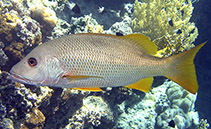| Family: |
Lutjanidae (Snappers), subfamily: Lutjaninae |
| Max. size: |
60 cm TL (male/unsexed) |
| Environment: |
reef-associated; brackish; marine; depth range 1 - 60 m |
| Distribution: |
Indo-Pacific: East Africa to the Marquesas and Line islands, north to the Ryukyu Islands, south to Australia. |
| Diagnosis: |
Dorsal spines (total): 10-10; Dorsal soft rays (total): 13-14; Anal spines: 3-3; Anal soft rays: 8-9. This species is distinguished by the following characters: body moderately deep to somewhat slender; greatest depth 2.6-3.0 in SL; preopercular notch and knob poorly developed; vomerine tooth patch crescentic, without a medial posterior extension; tongue smooth, no teeth; gill rakers of first gill arch 7 + 11-12 = 18-19 (including rudiments); caudal fin truncate to slightly emarginate; scale rows on back rising obliquely above lateral line. Colour generally whitish to pinkish with dusky scale margins; grey or brown on upper back and dorsal portion of head, a black spot, sometimes faint or absent, on back below anterior soft dorsal-fin rays (in juveniles, the spot is round and gradually shrinking and becoming horizontally elongate with increased growth); fins yellowish (Ref. 9821, 90102).
Description: dorsal profile of head gently to moderately sloped; preorbital width about equal to eye diameter (Ref. 9821). |
| Biology: |
Adults inhabit coral reef areas, usually close to shelter in the form of caves, large coral formations and wreckage. Usually solitary; occasionally occurring in small groups. They feed mainly on fishes and benthic crustaceans, primarily crabs (Ref. 37816) at night. Flesh is sometimes ciguatoxic, and commonly so in Tuvalu (Ref. 9513). |
| IUCN Red List Status: |
Least Concern (LC); Date assessed: 05 March 2015 Ref. (130435)
|
| Threat to humans: |
reports of ciguatera poisoning |
Source and more info: www.fishbase.org. For personal, classroom, and other internal use only. Not for publication.
